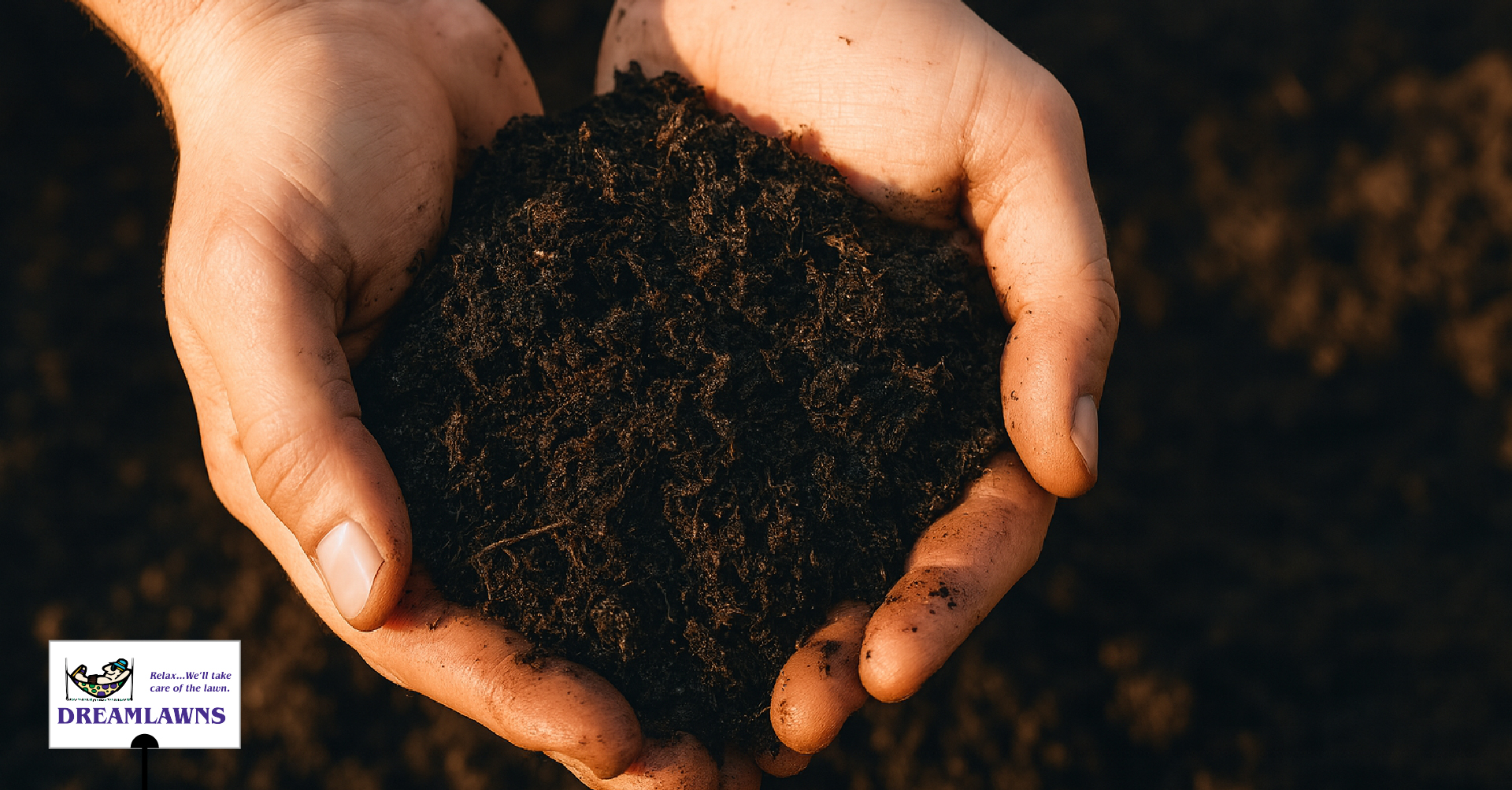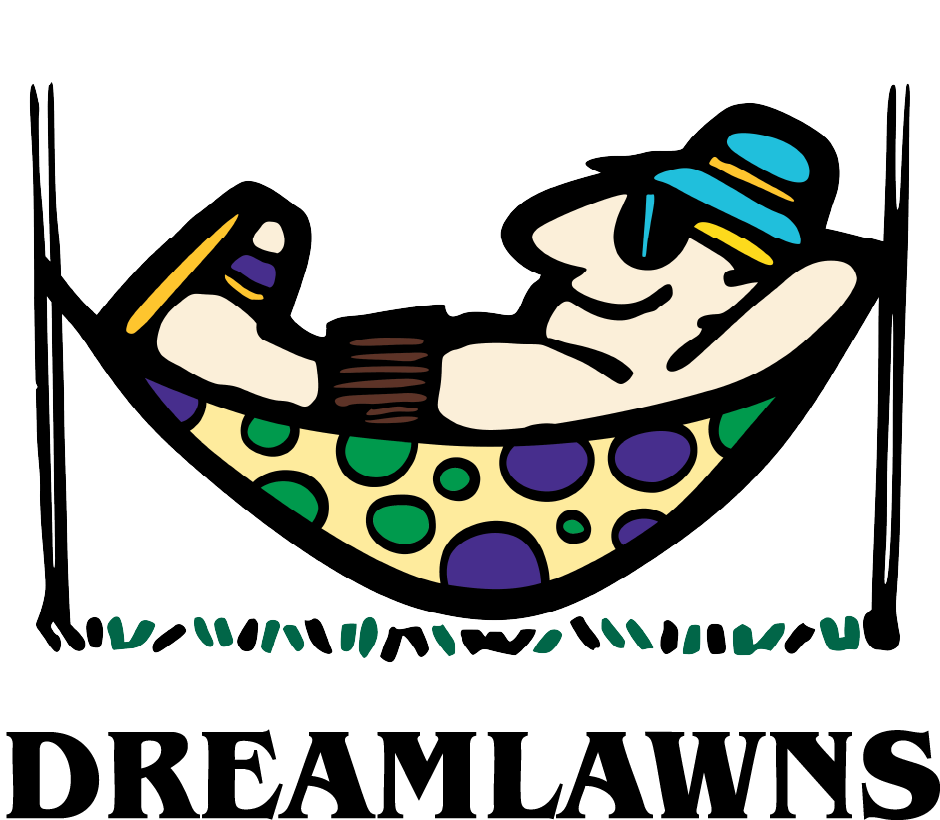
Dreamlawns Quick Cut: Healthy lawns begin with healthy soil. Fall is the best time to improve your lawn’s foundation with soil conditioning, pH adjustment, aeration, and fertilizing your lawn. Cooler weather and active root growth create ideal conditions for making lasting improvements that carry into spring. Dreamlawns offers professional soil testing, targeted treatments, and complete programs for Virginia Beach homeowners. Strengthen your soil now to enjoy thicker, greener turf year-round.
A lush, green lawn doesn’t start with the grass you see on the surface, it starts with the soil beneath your feet. Healthy soil provides the nutrients, structure, and moisture balance turf needs to thrive, while poor soil leads to thin, patchy grass that struggles no matter how much you fertilize or water.
Fall is the ideal season to focus on improving soil health. Cooler temperatures reduce stress on grass, rainfall helps support soil work, and roots remain active even as growth above ground slows down. By addressing soil issues now, you give your lawn the foundation it needs to survive winter and come back stronger in spring.
Why Soil Health Is the Foundation of a Strong Lawn
Every beautiful lawn begins below the surface. While grass blades give you the green curb appeal, it’s the soil beneath that determines how well turf grows, resists stress, and recovers year after year. When soil is compacted, unbalanced, or lacking organic matter, even the best treatments struggle to deliver lasting results.
The role of soil in lawn health is multifaceted:
Nutrient Delivery: Healthy soil acts like a pantry for your lawn, storing and releasing essential nutrients such as nitrogen, phosphorus, and potassium. It also supplies trace elements like iron, magnesium, and calcium, which are vital for turf color and vigor. Poor soil, on the other hand, either locks up nutrients where roots can’t access them or lets them wash away before plants can use them.
Water Retention & Drainage: Good soil holds onto moisture while still allowing excess water to drain away. This balance protects grass from the stress of both drought and oversaturation. Sandy soils, sometimes found in Virginia Beach, often drain too quickly, while compacted soils can trap water, both conditions weaken turf over time.
Root Development: Deep roots are the key to resilience. Loose, well-aerated soil gives roots space to grow downward, anchoring turf against heat, drought, disease, and pests. Shallow roots, often the result of poor soil conditions, leave grass vulnerable and quick to decline.
Soil Biology: Healthy soil is alive with beneficial microorganisms that help break down organic matter, recycle nutrients, and create natural defenses against disease. When soil health is poor, these microbial systems are disrupted, leaving turf without critical support.
Weed & Disease Resistance: Thick, healthy turf supported by strong soil outcompetes weeds naturally and recovers more quickly from fungal infections. Weak, compacted, or nutrient-poor soil creates thin turf, which is an open invitation for invasive weeds to take hold.
Put simply, your soil is the foundation for everything else. Fertilization, overseeding, and weed control can only work as intended if the soil itself is healthy enough to support them.
Why Fall Is the Best Season for Soil Improvements
While soil conditioning is valuable any time of year, fall offers the best window for making lasting changes. The combination of cooler air temperatures, active root growth, and more consistent rainfall in Virginia Beach creates ideal conditions for improving your lawn’s foundation.
Here’s why fall is the prime season for soil work:
- Cooler Temperatures, Less Stress: Grass isn’t fighting the heat of summer, which means energy can go toward root development and recovery.
- Roots Stay Active: Even as top growth slows, Fescue and other cool-season grasses continue building stronger, deeper roots well into late fall.
- Better Moisture Balance: Autumn rainfall helps water penetrate soil evenly, making treatments like lime, compost, or fertilizer more effective.
- Prepares Turf for Winter: Addressing soil issues now ensures your lawn heads into dormancy stronger, with reserves to withstand cold stress.
- Sets the Stage for Spring Green-Up: A healthy soil foundation in fall pays off when grass wakes up in spring, producing thicker, greener turf earlier in the season.
By making improvements in the fall, you’re working with nature’s timing instead of against it. Treatments applied now are absorbed more effectively, and the results carry forward into the next growing season.
Key Soil Health Improvements for Fall
Soil health isn’t improved by a single treatment, it’s the result of building structure, balance, and fertility over time. Fall offers the best opportunity to make meaningful improvements because turf is still active below the surface, storing energy and expanding its root system before winter dormancy.
The most effective soil improvements to focus on in the fall include:
- pH Adjustment: If the soil is too acidic or alkaline, it can lock up nutrients and reduce the effectiveness of fertilizers. While lime (to raise pH) or sulfur (to lower pH) can help correct those imbalances, timing is key. Because pH-altering products can interact with granular fertilizers, we recommend allowing at least 30 days between fertilizer applications and any lime or sulfur treatments. When properly timed, these adjustments help maintain balanced soil and maximize nutrient availability for healthy, resilient turf.
- Soil Conditioning with Organic Matter: Compost or organic soil conditioners improve the heavy, clay-based soils common throughout most of Virginia Beach by enhancing structure, promoting better drainage, and boosting oxygen flow to the roots. In areas closer to the oceanfront where soils are sandier, these materials help improve water retention. Organic matter also feeds beneficial microbes that recycle nutrients and strengthen soil biology, creating a healthier environment for long-term turf growth.
- Core Aeration: Compaction is one of the biggest threats to soil health. When soil becomes hard-packed, water and nutrients can’t penetrate, and roots are forced to stay shallow. Core aeration relieves this stress by pulling plugs of soil and creating open channels for air, water, and nutrients to reach the root zone.
- Fall Fertilization for Root Strength: Fertilization in fall is different from spring. Instead of pushing top growth, nutrients applied now support root development and energy storage. In fact, about 70% of the nitrogen your Fescue lawn needs each year should be applied during the fall months. This ensures grass has the reserves to withstand frost, disease, and winter dormancy while setting up for a faster, greener spring recovery.
When combined, these practices create soil that’s balanced, fertile, and better able to support thick, resilient turf. By focusing on soil conditioning, pH balance, aeration, and strategic fertilization now, you’re building a foundation that benefits your lawn long after fall has passed.
Common Signs of Poor Soil Health
Even if your lawn looks green on the surface, unhealthy soil beneath can quietly limit turf growth and resilience. Recognizing the warning signs early allows you to address soil issues before they become bigger problems.
Indicators your soil may need attention include:
- Thin, Patchy Grass: Weak or uneven turf growth often signals compacted or nutrient-poor soil.
- Hard, Compacted Ground: If it’s difficult to insert a screwdriver or garden tool into the soil, compaction is preventing roots from accessing air, water, and nutrients.
- Excess Weeds or Moss: Weeds thrive where grass is struggling, and moss often points to acidic, compacted, or poorly drained soil.
- Standing Water or Poor Drainage: Water pooling after rain suggests soil structure issues, while overly dry soil that resists absorbing water can also indicate trouble.
- Poor Response to Fertilization: If fertilizing your lawn produces little or no improvement, it may mean soil pH or structure is blocking nutrient uptake.
If you notice one or more of these signs, fall is the perfect time to correct the underlying issues through soil conditioning, aeration, and fertilizing your lawn with the right nutrients.
Professional Soil Care with Dreamlawns
Soil care isn’t a one-time fix, it requires the right balance of treatments and timing to truly strengthen your lawn’s foundation. At Dreamlawns, we combine science-based practices with local expertise to deliver long-term results.
Here’s how we approach soil health for Virginia Beach lawns:
- Soil Testing & Analysis: Every lawn is unique. We evaluate pH, nutrient levels, and soil structure to identify exactly what your yard needs to thrive.
- Targeted Soil Conditioning: From compost and organic matter to professional-grade soil conditioners, we improve structure, enhance water retention, and boost microbial activity.
- Core Aeration Services: Relieving compaction is one of the fastest ways to improve soil health. Dreamlawns provides professional equipment and expertise to ensure deep, even results.
- Fertilization Programs: Fall is the season when Fescue turf stores energy. That’s why about 70% of your lawn’s nitrogen should be applied during this period. Our fertilization plans are designed to maximize root growth now, setting the stage for early spring green-up. If you’ve been wondering about the best approach to fertilizing your lawn, we provide a tailored program to match your soil needs.
- Year-Round Lawn Care Plans: Soil health is never “finished.” Our ongoing programs adapt to the seasons, ensuring your lawn receives the right treatments for weed control, fertilization, aeration, and soil improvement all year long.
With Dreamlawns, you’re not just treating symptoms on the surface, you’re building a healthy foundation that supports thicker, greener, and more resilient turf for years to come.
Strengthen Your Soil, Strengthen Your Lawn
A lawn is only as strong as the soil it grows in. Without healthy soil, turf struggles to take in nutrients, water, and oxygen, no matter how much effort you put into mowing, watering, or fertilizing. Fall provides the perfect opportunity to address soil issues, from compaction and pH imbalance to nutrient shortages, while roots are still active and preparing for winter.
At Dreamlawns, we specialize in soil conditioning, aeration, and fertilizing your lawn with treatments that improve soil health from the ground up. Our year-round lawn care programs ensure your soil gets what it needs in every season, creating a thicker, greener lawn that’s resilient against stress, weeds, and disease.
Don’t wait until spring to discover your soil is holding your lawn back. Contact us today to schedule a property assessment and give your turf the strong foundation it deserves.
Dreamlawns provides superior lawn care service to Virginia Beach & Chesapeake VA residents.




